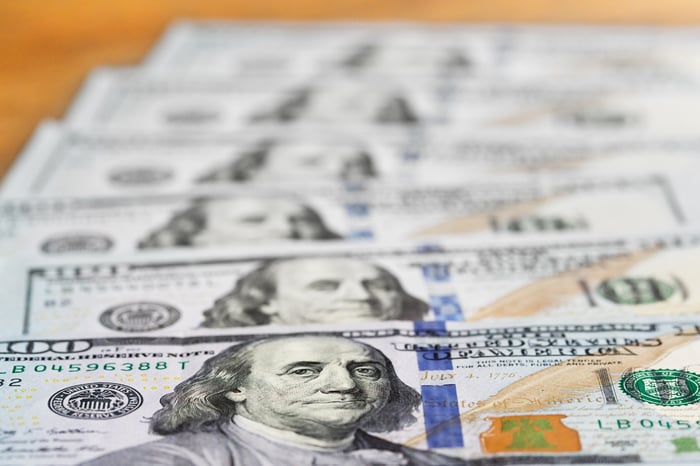There are a lot of ways to grow your nest egg on Wall Street. Investing in dividend stocks over the long run just happens to be a strategy with an exceptionally high return rate.
In 2013, the wealth management segment of JPMorgan Chase, America's largest bank by assets, released the results of a study that compared the performance of companies that initiated and grew their payouts between 1972 and 2012 to that of public companies that didn't pay a dividend to their shareholders. Unsurprisingly, the dividend stocks absolutely stomped the non-payers in the return column.
Over the stretch of four decades, the dividend stocks produced an annualized return of 9.5%. You'll note this is well ahead of the long-term annualized return rate of all commodities, as well as housing and bonds. Meanwhile, companies without a dividend generated a measly annualized return of 1.6% over 40 years.

Image source: Getty Images.
In a perfect world, investors are going to net supercharged yields with virtually no risk to their principal from time-tested companies. But in the real world, risk and yield tend to go hand in hand. In other words, ultra-high-yield stocks (i.e., those with yields 4 or more times greater than the S&P 500's yield) can occasionally be more trouble than they're worth.
But this isn't always the case. There exists a small number of truly time-tested ultra-high-yield stocks that have raised their base annual payouts for at least the past 25 years.
If you want to generate $600 in super safe annual dividend income, simply invest $7,625 (split equally, three ways) into the following three infallible ultra-high-yield stocks, which are sporting an average yield of 7.88%.
Altria Group: 9.8% yield
The first exceptional ultra-high-yield stock that can help you bring home $600 in safe annual dividend income is tobacco giant Altria Group (MO 0.68%). Altria's shares are yielding close to 10%, and the company has raised its dividend 57 times over the past 53 years. Suffice it to say, this payout is about as rock-solid as they come.
The clear challenge the tobacco industry faces is a shrinking pool of users for traditional tobacco products, such as cigarettes. With consumers becoming more aware of the potential negative health effects of long-term tobacco use, adult smoking rates in the U.S. have fallen by more than 30 percentage points to 11.5% since 1965.
Although volume declines are never ideal, Altria Group has a couple of catalysts in its corner. Chief among them is its pristine pricing power.
Tobacco products contain nicotine, which is an addictive chemical. This desire for cigarettes and other tobacco products allows Altria to raise its prices and typically offset any adverse impacts from inflation and reduced volume. Altria's premium brand, Marlboro, accounts for more than a 42% share of retail cigarette sales in the U.S., which is another reason the company has little trouble passing along higher prices to consumers.
But raising prices is just one pathway to moving the needle for Altria. Perhaps its most exciting move was acquiring electronic-vapor company NJOY Holdings for $2.75 billion in early June. Six of NJOY's products have received marketing granted orders (MGOs) from the U.S. Food and Drug Administration. These MGOs are what give NJOY the authority to market its e-vapor products. Meanwhile, most e-vapor products lack MGOs and could, eventually, be pulled from retail shelves. Buying NJOY sets Altria up to benefit from the faster-growing vape market.
The valuation also makes sense. While Altria isn't going to drop any jaws with its traditional low- to mid-single-digit sales growth, its forward-year price-to-earnings ratio of 8 is historically inexpensive. Tack on a 9.8% yield, and you have a smoking-hot deal for income and value seekers.
Enterprise Products Partners: 7.7% yield
A second infallible ultra-high-yield stock that can help you generate $600 in super safe annual dividend income from a starting investment of $7,625 (split equally in thirds) is energy stock Enterprise Products Partners (EPD 0.22%). Enterprise has increased its base annual distribution for 25 consecutive years, with the company's board returning an aggregate of $50.8 billion to its investors, inclusive of share buybacks, since its initial public offering in July 1998.
For some investors, the idea of putting their money to work in an oil and gas stock may not be appealing. Less than four years ago, COVID-19 lockdowns cratered demand for energy commodities, which hit drilling companies hard. Thankfully, Enterprise Products Partners avoided this mess.
Enterprise is a midstream energy company. Think of it as a middleman tasked with moving and storing energy commodities and refined products. It has the capacity to store more than 260 million barrels of liquids, as well as 14 billion cubic feet of natural gas. Additionally, it operates in excess of 50,000 miles of transmission pipeline.
What makes midstream energy companies so appealing to income seekers is the nature of their contracts with upstream providers (i.e., drillers). Most of Enterprise Products Partners' contracts are long-term and fixed-fee. The fixed-fee aspect removes any impact of inflation and crude oil spot price volatility from the equation. In short, it leads to predictable operating cash flow in pretty much any economic climate.
The importance of being able to accurately forecast its operating cash flow can't be overstated. Having a transparent view of what it'll generate is what gives Enterprise's management team the confidence to outlay capital for new projects. The company currently has approximately $6.8 billion in approved major projects underway, with a clear focus on expanding its natural gas liquids operations.
To keep with the theme, the valuation is attractive, as well. Enterprise shares can be picked up for less than 10 times forward-year earnings, which is a cheap price to pay for an energy middleman with a quarter of a century of superior operating performance in its back pocket.

Grocery stores are Realty Income's top category by annualized contractual rent. Image source: Getty Images.
Realty Income: 6.13% yield
The third infallible ultra-high-yield stock capable of yielding $600 in super safe annual dividend income from a beginning investment of $7,625 (splits three ways) is retail real estate investment trust (REIT) Realty Income (O -0.09%). Realty Income is a monthly dividend payer yielding 6.1% that's increased its payout for 104 consecutive quarters.
The logical knock against retail REITs is that consumers are steadily shifting their buying habits to e-commerce. There are also clear signs that the U.S. economy could weaken in the coming quarters. It's not uncommon for consumers to pare back their spending during economic downturns, which is typically not great news for retail REITs.
On the other hand, Realty Income has a few tricks up its sleeve to help it weather any storm.
For instance, approximately 91% of its more than 13,000 commercial real estate properties are tied to companies in industries that are resilient to economic downturns. Just over 35% of its annualized contractual rent comes from grocery stores, convenience stores, dollar stores, and drug stores. Consumers are regularly shopping at stores in all four of these categories regardless of how well or poorly the U.S. economy is performing.
Realty Income is also enjoying substantially higher occupancy rates by having historically stable, time-tested businesses as renters. Whereas the median REIT has averaged a 94.2% occupancy rate since the start of the century, Realty Income's diversified portfolio sits at an average occupancy rate of 98.2% over the same stretch.
Don't overlook its diversification beyond traditional retail, either. Beginning last year, Realty Income began shifting into the casino industry. Meanwhile, on Oct. 30, it announced it would be acquiring Spirit Realty Capital in an all-share deal valued at $9.3 billion. This complementary acquisition will further diversify Realty Income's vast commercial real estate portfolio and be accretive to its adjusted funds from operations.
Valued at less than 12 times forward-year cash flow, Realty Income is cheaper than it's been in at least a decade.





